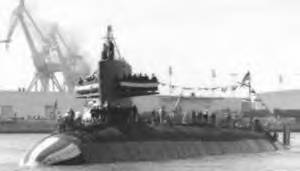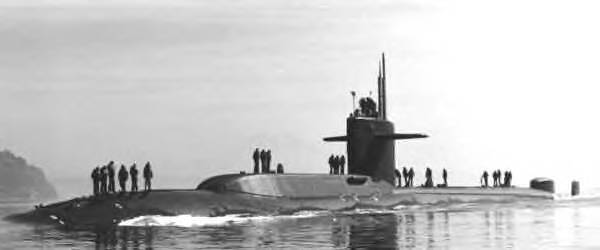USS Parche SSN-683 from
Wikipedia
| USS Parche (SSN-683), a Sturgeon-class submarine,
was the second ship of the United States Navy to be named for the parche,
a small, coral reef butterfly fish. Parche is the most decorated ship in
U.S. Navy history.
Construction and commissioning
The contract to build Parche was awarded to Ingalls
Shipbuilding in Pascagoula, Mississippi, on 25 June 1968 and her keel was
laid down there on 10 December 1970. She was launched on 13 January 1973,
sponsored by Mrs. Philip A. Beshany, and commissioned on 17 August 1974
with Commander Richard N. Charles in command.

Parche is launched at Pascagoula,
Mississippi, on
13 January 1973. |
Operational history
1974-1979
In 1975-76 Parche was in the Mediterranean Sea.
Upon discovery of some relics from World War II in December 1975, the Parche
was called the "Prize of the Mediterranean". The Parche docked in Italy
a week late just in time for Christmas. Returned from the Med in March
1976. |
.jpg)
USS Parche (SSN-683) off Pearl
Harbor, Hawaii, sometime prior to October 1985. The structure on the after
part of her casing is a permanently attached swimmer lock-out chamber,
although described under its cover story as Deep Submergence Rescue Vehicle.
Her ship's insignia is at lower right.
| Name: |
USS Parche |
| Commisioned: |
1974 |
| Length: |
302 ft as built
401 ft after lengthing 1991 |
| Beam: |
31 ft 8 in |
Speed:
surfaced |
15 knots |
| submerged |
25 knots |
| Complement: |
112 as built
179 aftr 1991 modifications |
|
|
Parche served as a unit of the United States Atlantic
Fleet Submarine Force until 1976 before transferring to the United States
Pacific Fleet in October 1976. Once arriving at her new home port at Mare
Island Naval Shipyard in Vallejo, California, Parche received ocean engineering
modifications. Parche deployed on a shakedown training cruise in August
and September 1978.
Operation Ivy Bells, 1979
Parche successfully tapped into Soviet underwater
military communication cables in the Barents Sea in 1979 as part of Operation
Ivy Bells.
1979-2004
During her career, Parche was involved in recovering
Soviet missile fragments from the seabed following test launches. Much
of her operational history was spent undertaking missions of a clandestine
nature, and as of late 2009 a vast majority of the missions the ship undertook
remain classified.

Parche after the extension of her
hull; note the
length of her bow in comparison
to its length in
the photograph of her launching
above. |
From 1987 to 1991, Parche underwent an extended
refueling overhaul at Mare Island Naval Shipyard during which she was modified
for research and development work. A 100-foot (30 m) - long extension was
added to her hull just forward of her sail. The added section was flat-topped
(looking somewhat like the missile deck of a ballistic missile submarine)
and provided the space required to support a larger crew and additional
equipment. These additions included an extensive array of signals-intelligence-collecting
antennas, electronic gear, and other navigational and ocean engineering
equipment. The overhaul also added many auxiliary navigational and maneuvering
features, including both upward and |
forward-facing short-range sonars, and a suite of
armored spotlights and closed-circuit television cameras for under-ice
operations.
Upon completion of her modifications in 1991,
Parche began a new mission as part of Submarine Development Squadron 5.
She resumed operations in the Pacific Fleet in 1992.
Parche was transferred to a new home port, Naval
Base Kitsap at Bangor, Washington, in November 1994.
Parche may have recovered Chinese missile fragments.
In 1995 and 1996, the People's Republic of China launched DF-21 and DF-15
ballistic missiles into the sea surrounding Taiwan to deter Taiwan from
moving toward independence; Robert Karniol writes: "I suspect that "the
Parche might have gone after these Chinese missile fragments", and "I suspect
that Beijing gave away some useful missile secrets."
Decommissioning and disposal
2.jpg) . .
Parche returns to port for the
last time at Naval Base Kitsap at Bangor, Washington, on 20 September 2004. |
On 19 October 2004, a decommissioning ceremony
took place at Puget Sound Naval Shipyard at Bremerton, Washington; she
was officially decommissioned on 18 July 2005 and stricken from the Naval
Vessel Register the same day. The wardroom of the oldest submarine in the
fleet carries Richard O'Kane's personal cribbage board, and upon the Parche's
decommissioning the board was transferred to the next oldest boat: USS
Los Angeles (SSN-688). Her scrapping at Puget Sound Naval Shipyard via
the Ship and Submarine Recycling Program was completed on 30 November 2006.
Parche's research and development duties will
be assumed by Jimmy Carter, a Seawolf-class submarine whose construction
period was extended to include modifications that will allow her
to carry out the same types of research and development. |
According to Robert Karniol, Jimmy Carter in succeeding
Parche, has become "Washington's premier spy submarine."
Military awards
Parche is the most decorated ship in U.S. Navy
history, receiving a total of nine Presidential Unit Citations and ten
Navy Unit Commendations. The submarine also received thirteen Navy Expeditionary
Medals during her thirty years of service.
Commemoration
Parche's sail was preserved. During the summer
of 2006 it was moved from Puget Sound Naval Shipyard to a maritime park
in downtown Bremerton.
|